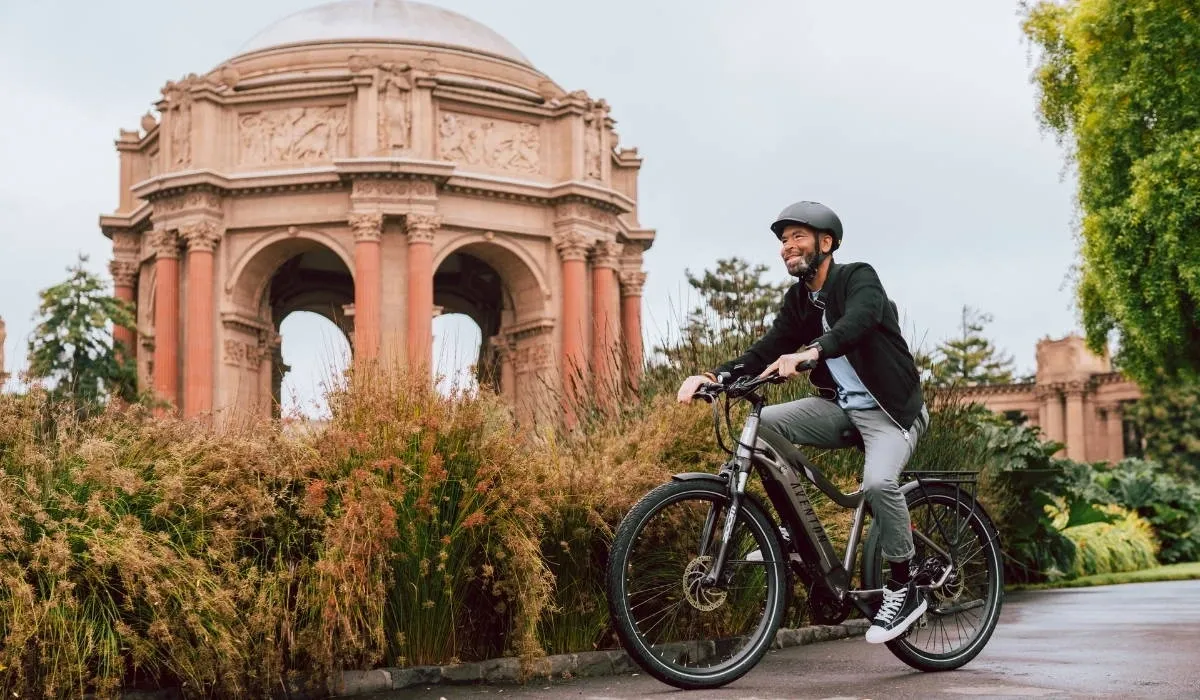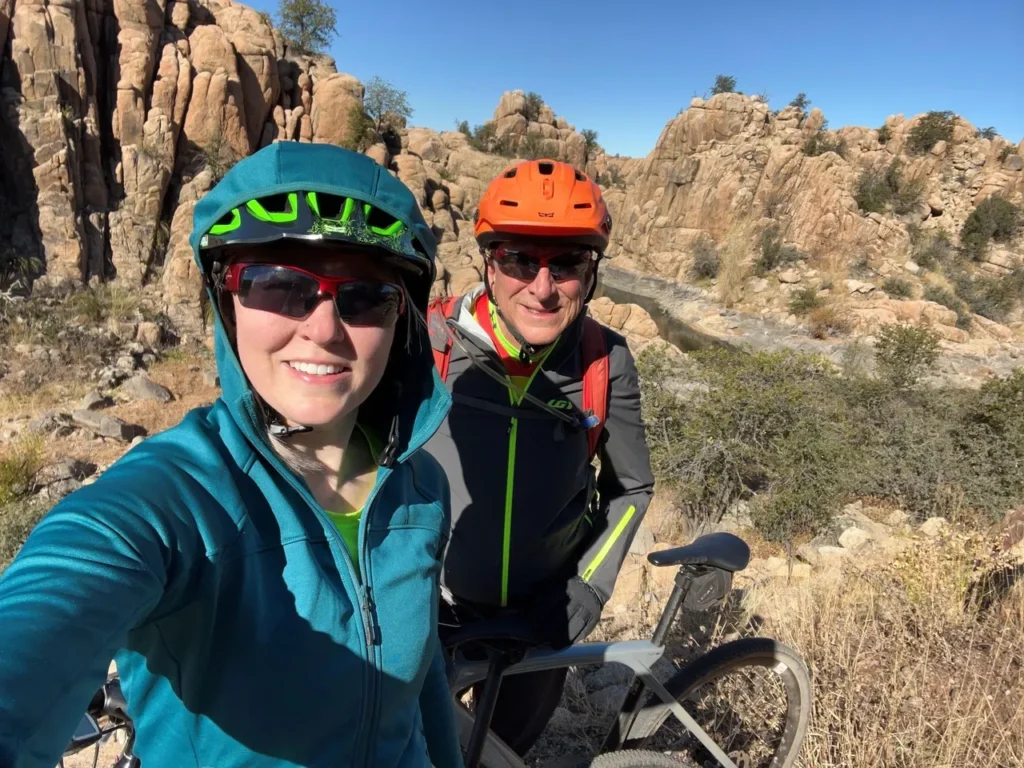
Ride Safe
Safe Riding Tips
Road, trails, backcountry, no matter what, there are simple steps to take that will help you stay safe. All bicycles can reach phenomenal speeds. On the road, going 40mph downhill is not unusual.
- Wear a helmet – impacts hurt. Even a small fall can cause serious injury. Helmets are cheap. Your head is not. Though not required by law for adults, in AZ, children must wear a helmet.
- Practice – improve your confidence and competence. Ride at your level. Randy’s axiom: walk today, ride tomorrow. There is no shame in walking through a challenging obstacle. Practice riding in a comfortable location to get familiar with your bike first. It’s pretty demoralizing to get a new bike only to crash. Take your time and slowly take on more challenging routes. If you just got an e-bike, ride with the power off for a bit. Then, add power after some practice.
- Check your bike – put air in the tires and check for loose bolts. It only takes a minute to do a fast pass. Bikes have many wear items and things that need periodic adjustment. Get comfy with your bike. Listen for unusual sounds. Look for bent or loose parts. Wear items include brakes, tires, cables, oil and fluids, and pivot points. Learn what these all should look and feel like.
- Know your path – approach unfamiliar paths with alertness. Reckless abandonment could hurt you or others. Bring a map. You could get lost. Cell phones don’t always work in the backcountry. A Garmin or paper map sure can come in handy. Share your route. Let others know where you plan to go too.
- Visibility – think “be seen.” Stand out is my motto. Day or night, bright and reflective clothing is great on the road and even advised on the trail. Oncoming riders could be riding fast and not see you. The simple fact is not everyone may be alert. Hikers often have children with them or a pet. They don’t intend to block the path; they are just enjoying the day. Call out, “on your left,” or “passing.”
- Lights – safety and path illumination. Flashing lights are amazingly effective at repelling cars and daydreaming bicyclists. At night, a good light can make travel safe, as well as brighten the path ahead. At night, it’s the law.
- Ride with the flow – ride with the traffic. Yield to cars, they are big. Angry drivers are no fun when you are on a bike. Resist the urge to make snarky comments about a driver. And, especially, avoid ugly hand gestures.

- Obey traffic laws – share the road. Stop at controlled intersections and stop signs. It makes sense, but it is so easy to evade the rules. Know the rules for e-bikes. Did you know Arizona has a bicycle speed limit of 20mph? Crazy. Either way, obey the posted speed limit. Be alert, some bike paths and trails restrict e-bikes.
- No sidewalks – they are for pedestrians. Not only that but riding on the sidewalk exposes you to many hazards. Cars don’t see you, pedestrians are annoyed, and it is unlawful.
- The triangle – Equestrian-Pedestrian-Bicycle. It’s simple; bikes must yield to others. And, although cars are supposed to yield to bikes, it is doubtful an unintended encounter with 3,000 pounds is advisable. I go so far as to stop and wait for horseback riders to pass or leave a lot of time for them to waive me to pass when I come up behind them. Downhill bike traffic should yield to uphill riders. Be polite and courteous. Some riders may not be competent or knowledgeable of etiquette rules. Just let ’em pass.
- Focus ahead – that front wheel is hypnotic; look up. We need to see the horizon to maintain the best balance. It is easy to get fixated on the front wheel so you can see the path. However, it is better to look out about fifteen feet. If you turn to look, the bike may follow. Turning your head causes the bike to turn with you. Equally, if you need to grab a drink, move your hands closer to the stem; it improves one-handed control.
- Bell – you need a way to alert others of your approach. I like using a small cowbell on my bars that alerts hikers I am coming down the trail. A manual bell is good too. Ding-ding, “I’m coming through.”
- Signal your intent – in traffic and on the trail, let everyone around you know your plans. Sudden lane departures in traffic, cross-traffic, and even other cyclists all need warning when you change your direction. It’s nice for riders behind you on the path too. Sometimes I will even point at hazards when I ride with a group, alerting folks behind me to take heed.
- Single file – stay right. Let others pass you. On the street, it’s not polite to hog the road. In a bike lane, encroaching on the line infuriates cars, and they may become aggressive. Think twice about riding a road without ample space for a bike. It could be dangerous. A good rule is to have at least three feet between you and traffic. If you are passing parked cars, leave five feet between you and the car (in case they open their door).
- Driveways and side streets– drivers do not see bikes; they are looking for cars. When you transverse a driveway, anticipate cars. Be wary. The worst way to cross a driveway is if you are on the sidewalk. Many nasty accidents happen on a driveway or side street. These transitions also hold many hazards, like cracks, potholes, and broken pavement. Nothing is worse than getting your front wheel caught in a groove, tossing you off your bike.

- Clothing – fit tight, wear layers. Multiple layers keep you warm when you start and let you shed items as you warm up. Hot or cold, sweat is your enemy. Controlling airflow and moisture is the key to staying comfortable. Lightweight coverings work best in the sun. Bare skin is fun, but actually, a lightweight cover works better. Avoid loose clothing for safety. Plus, all that flapping around is annoying.
- Be prepared – water, sunscreen, first aid, map, tire repair, pump, multi-tool, sunglasses, snack, windbreaker, gloves, lock, headlight/taillight, and a phone. I keep a hydration backpack filled with all my items. I grab it for every ride. However, you may not need much if you are only making a short urban ride. Lastly, let someone know where you are going and when you will return.
Thanks for reading. Want more e-bike facts or frequently asked questions? Read: E-Bike FAQs.
Copyright Randy Archer 2024
